Urticales is an order of flowering plants. Before molecular phylogenetics became an important part of plant taxonomy, Urticales was recognized in many, perhaps even most, systems of plant classification, with some variations in circumscription. Among these is the Cronquist system (1981), which placed the order in the subclass Hamamelidae [sic], as comprising:

The Araliaceae are a family of flowering plants composed of about 43 genera and around 1500 species consisting of primarily woody plants and some herbaceous plants commonly called the ginseng family. The morphology of Araliaceae varies widely, but it is predominantly distinguishable based on its woody habit, tropical distribution, and the presence of simple umbels.

Pinnation is the arrangement of feather-like or multi-divided features arising from both sides of a common axis. Pinnation occurs in biological morphology, in crystals, such as some forms of ice or metal crystals, and in patterns of erosion or stream beds.
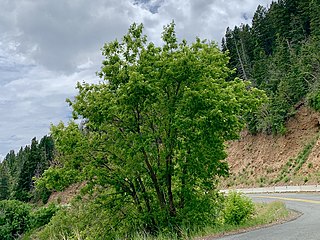
Acer negundo, the box elder, boxelder maple, Manitoba maple or ash-leaved maple, is a species of maple native to North America. It is a fast-growing, short-lived tree with opposite, compound leaves. It is sometimes considered a weedy or invasive species, and has been introduced to and naturalized throughout much of the world, including in South America, Australia, New Zealand, South Africa, much of Europe, and parts of Asia.
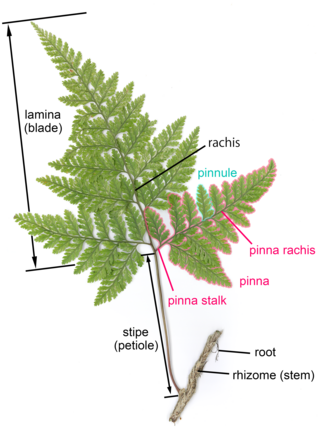
A frond is a large, divided leaf. In both common usage and botanical nomenclature, the leaves of ferns are referred to as fronds and some botanists restrict the term to this group. Other botanists allow the term frond to also apply to the large leaves of cycads, as well as palms (Arecaceae) and various other flowering plants, such as mimosa or sumac. "Frond" is commonly used to identify a large, compound leaf, but if the term is used botanically to refer to the leaves of ferns and algae it may be applied to smaller and undivided leaves.

The curry tree, Murraya koenigii or Bergera koenigii, is a tropical and sub-tropical tree in the family Rutaceae, native to Asia. The plant is also sometimes called sweet neem, though M. koenigii is in a different family to neem, Azadirachta indica, which is in the related family Meliaceae.

Mahonia is a genus of approximately 70 species of evergreen shrubs and, rarely, small trees in the family Berberidaceae, native to eastern Asia, the Himalaya, North and Central America. They are closely related to the genus Berberis and botanists disagree on whether to recognize a separate Mahonia. Many botanists prefer to classify Mahonia as a part of Berberis because several species in both genera are able to hybridize, and because there are no consistent morphological differences between the two groups other than the leaf pinnation. However, recent DNA-based phylogenetic studies retain the two separate genera, by clarifying that unifoliolate-leaved Berberis s.s. is derived from within a paraphyletic group of shrubs bearing imparipinnate evergreen leaves, which are then divided into three genera: Mahonia, Alloberberis, and Moranothamnus ; a broadly-circumscribed Berberis would also be monophyletic.
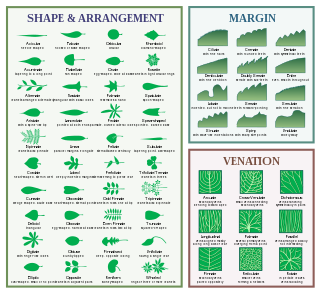
The following terms are used to describe leaf morphology in the description and taxonomy of plants. Leaves may be simple or compound. The edge of the leaf may be regular or irregular, may be smooth or bearing hair, bristles or spines. For more terms describing other aspects of leaves besides their overall morphology see the leaf article.

Trochodendraceae is the only family of flowering plants in the order Trochodendrales. It comprises two extant genera, each with a single species along with up to five additional extinct genera and a number of extinct species. The living species are native to south east Asia. The two living species both have secondary xylem without vessel elements, which is quite rare in angiosperms. As the vessel-free wood suggests primitiveness, these two species have attracted much taxonomic attention.

Rodgersia is a genus of flowering plants in the Saxifragaceae family. Rodgersia are herbaceous perennials originating from east Asia.

Cussonia is a genus of plants of the family Araliaceae, which is native to the Afrotropics. It originated in Africa and has its center of distribution in South Africa and the Mascarene Islands. Due to their striking habit, they are a conspicuous and easily recognizable group of plants. Their genus name commemorates the botanist Pierre Cusson. The Afro-Malagasy and Asian Schefflera, and Afrotropical Seemannaralia genera are related taxa that share several of its morphological characteristics, among which the leaves borne on the end of branches, inflorescences carried on terminal branches or stems, and reduced leaf complexity in developing inflorescences.

The Cleomaceae are a small family of flowering plants in the order Brassicales, comprising about 300 species in 10 genera, or about 150 species in 17 genera. These genera were previously included in the family Capparaceae, but were raised to a distinct family when DNA evidence suggested the genera included in it are more closely related to the Brassicaceae than they are to the Capparaceae. The APG II system allows for Cleomaceae to be included in Brassicaceae. Cleomaceae includes C3, C3–C4, and C4 photosynthesis species.
Regional floras typically contain complete dichotomous keys for identification of trees and other plants to species. The following guide originates from Our Native Trees and How to Identify Them by Harriet L. Keeler and applies to some flowering trees which are indigenous to the region extending from the Atlantic Ocean to the Rocky Mountains and from Canada to the northern boundaries of the southern states, together with a few well-known and naturalized foreign trees. This guide excludes conifers and is not an exhaustive list of all trees known to occur in the region.
This page provides a glossary of plant morphology. Botanists and other biologists who study plant morphology use a number of different terms to classify and identify plant organs and parts that can be observed using no more than a handheld magnifying lens. This page provides help in understanding the numerous other pages describing plants by their various taxa. The accompanying page—Plant morphology—provides an overview of the science of the external form of plants. There is also an alphabetical list: Glossary of botanical terms. In contrast, this page deals with botanical terms in a systematic manner, with some illustrations, and organized by plant anatomy and function in plant physiology.
This glossary of botanical terms is a list of definitions of terms and concepts relevant to botany and plants in general. Terms of plant morphology are included here as well as at the more specific Glossary of plant morphology and Glossary of leaf morphology. For other related terms, see Glossary of phytopathology, Glossary of lichen terms, and List of Latin and Greek words commonly used in systematic names.
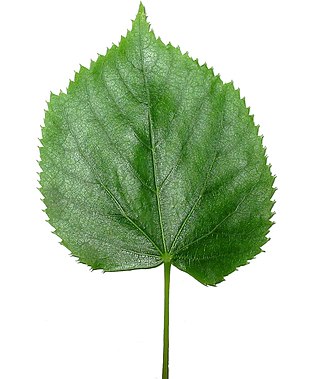
A leaf is a principal appendage of the stem of a vascular plant, usually borne laterally aboveground and specialized for photosynthesis. Leaves are collectively called foliage, as in "autumn foliage", while the leaves, stem, flower, and fruit collectively form the shoot system. In most leaves, the primary photosynthetic tissue is the palisade mesophyll and is located on the upper side of the blade or lamina of the leaf but in some species, including the mature foliage of Eucalyptus, palisade mesophyll is present on both sides and the leaves are said to be isobilateral. Most leaves are flattened and have distinct upper (adaxial) and lower (abaxial) surfaces that differ in color, hairiness, the number of stomata, the amount and structure of epicuticular wax and other features. Leaves are mostly green in color due to the presence of a compound called chlorophyll which is essential for photosynthesis as it absorbs light energy from the sun. A leaf with lighter-colored or white patches or edges is called a variegated leaf.
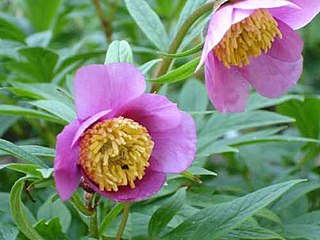
Paeonia veitchii is a species of herbaceous perennial peony. The vernacular name in China is 川赤芍. This species is ½-1 m high, has a thick irregular taproot and thin side roots, and deeply incised leaves, with leaflets themselves divided in fine segments. It has two to four fully developed flowers per stem, that may be pink to magenta-red or rarely almost white. It is known from central China.

Polyscias fruticosa, or Ming aralia, is a perennial plant, dicot evergreen shrub or dwarf tree native to India. The plant grows fairly slowly but can reach up to 1 to 2 meters in height. The leaves are of a dark green pigment, glossy in texture, and are tripinnate and appear divided. Individual leaves vary from narrowly ovate to lanceolate and are about 10 cm long.
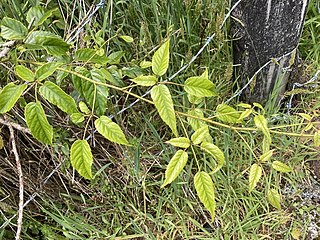
Rubus cissoides, commonly called bush lawyer or tātarāmoa in te reo Māori, is a species of flowering plant in the family Rosaceae, endemic to New Zealand. Alan Cunningham described R. cissoides in 1839. Plants of this species of are perennial scrambling vines with compound leaves with 3-5 leaflets each up to 15 cm long, reddish prickles on the branches, white flowers from September to November and red berries from December to April. The conservation status of R. cissoides is Not Threatened, it is widespread on all three main islands of mainland New Zealand, and it has been used by Māori as food, medicines and construction materials.
Rhus republicensis is an extinct species of flowering plant in the sumac family, Anacardiaceae. The species is known from fossil leaves found in the early Eocene deposits of northern Washington state in the United States. The species was first described from fossil leaves found in the Klondike Mountain Formation. R. republicensis likely hybridized with the other Klondike Mountain formation sumac species Rhus boothillensis, Rhus garwellii, and Rhus malloryi.

















